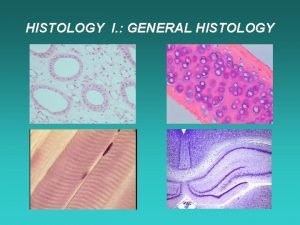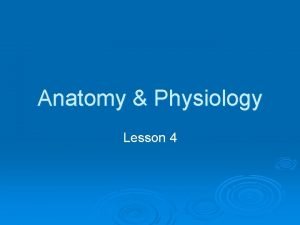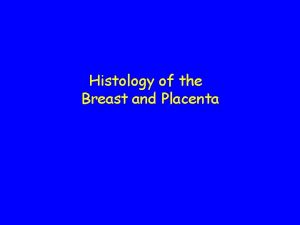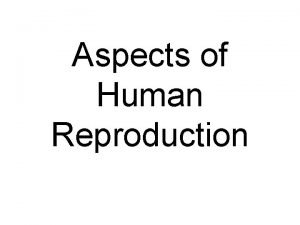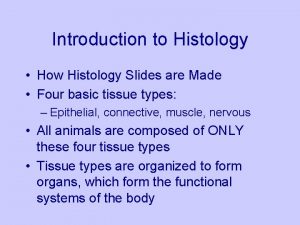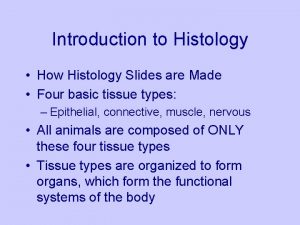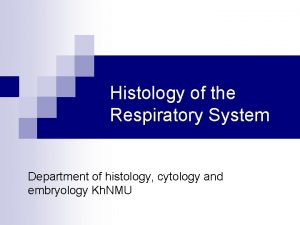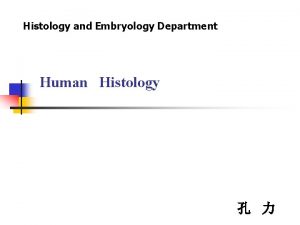Chapter 6 Histology What is Histology is the




































- Slides: 36

Chapter 6 Histology

What is Histology is the study of tissues and how they are arranged into organs. histo- tissue ology- study of Objectives: Name, draw, recognize and differentiate the function of the four primary classes and their subcategories which adult tissues are classified.

Chapter 6 Histology 1) Introduction -tissues a) multicullar structure – tissues contain cells of similar type. The cells work together to perform a specific function. b)cells and matrix – 1) matrix- extracellular material containing protein and mineral salts. 2) fluid surrounding cells is the interstitial fluid (Inter - between cells vs. Intra – inside a cell)

Chapter 6 Histology 2) Embryonic tissues- tissues from which all other tissues will arise. Starts with fertilized egg. Forms 3 layers (strata) called the primary germ layers. a) ectoderm (outer) -forms epidermis & nervous system b) endoderm (inner)-forms mucous membrane lining GI tract & respiratory system and digestive glands c) mesoderm (middle)-forms mesenchyme that gives rise to muscle, bone, blood and other connective tissues

Chapter 6 Histology 3) 4 basic tissue types (adult) – a) epithelial 1) one or more cell layers thick, free surface 2) simple or stratified 3) coverings –protection, secretion absorption

Chapter 6 Histology 3) 4 basic tissue types (adult) – b) connective 1) extensive extracellular matrix; collagen (flexible but strong), elastin (elastic qualities) 2) support, binding, protective 3) Connective tissue proper- Loose (adipose (fat)) tissue, Areolar (loosely binds epithelial cells to deeper tissue, and Reticular (supportive framework for lymphatic organs.

Epithelial Tissue There are two major categories of epithelial tissue: membranous and glandular. Membranous: The outer layer of skin, inner lining of cavities and lumina and coverings of visceral (internalespecially the heart, lungs, liver, pancreas or intestines) organs. Glandular: specialized tissue that form secretory portions of glands.

Membranous- Simple Epithelial Tissue: single layer thick and is located where diffusion, absorption, filtration and secretion are principle functions. Some cells contain cilia that move materials across cell surfaces. Other cells contain microvilli that increase surface area for absorption.

Membranous- Simple Epithelia Simple Squamous Epithelium : Flattened , irregularly shaped cells with an oval centrally located nucleus. Write down three places in the body where each type of epithelial cell can be found.

Membranous- Simple Epithelia Simple Columnar Epithelium : Tall, columnar cells with a single nucleus located near the basement membrane. Specialized unicellular glands called Goblet cells are scattered through this tissue. Goblet cells secrete a lubricative and protective mucus. Write locations.

Membranous- Simple Epithelia Simple Cuboidal Epithelium: Tightly fitted cube shaped cells found lining the lumina of small ducts and tubules that have excretory, secretory and absorptive functions. Write locations.

Membranous- Simple Epithelia Simple Ciliated Columnar Epithelium: Similar to columnar cells but with cilia along the free surface. Cilia do what? Where are they located?

Membranous- Simple Epithelia Pseudostratified Ciliated Columnar Epithelium: Ciliated columnar epithelium that appears to be layeredbut each cell is anchored to the basement membrane. Write location.

Membranous- Stratified Epithelia : Tissue consisting of two or more layers. This tissue is primarily protective and enhanced by rapid cell divisions. Stratified epithelia are classified according to the shape of the surface layer of cells. Why is this tissue not well suited for absorption and secretion?

Membranous- Stratified Epithelia Stratified Squamous Epithelium: Composed of a variable number of cell layers that are flattest at the surface. Mitosis occurs at only at the deepest layers. Keratinized: Contains keratin (strengthening protein) Nonkeratinized: No keratin, called mucosa Where are they located?

Membranous- Stratified Epithelia Stratified Cuboidal Epithelium: Consists of two or three layers of cuboidal cells where stratification provides a more robust lining. What location?

Membranous- Stratified Epithelia Transitional Epithelium: similar to nonkeratinized stratified squamous epithelium. Where is this located and what is the specific function?

Chapter 6 Histology Body Membranes: Thin layers of epithelial tissue that cover, support and protect visceral organs and line body cavities. Mucous Membrane: secrete thick mucus to lubricate and protect associated organs. Oral and nasal cavities, respiratory, reproductive, urinary and digestive system. Serous Membrane: secrete serous fluid to help protect. Pleurae (lungs), Pericardial (heart), Peritoneal (adominopelvic)

Glandular Epithelia: Tiny invaginations (infoldings) of membranous epithelia that give rise to specialized secretory structures called exocrine glands. Unicellular: Single cells (Example ? ) Multicellular: These can be simple or compound are composed of both secretory cells and cells that form the walls of ducts.

Membranous- Stratified Epithelia Multicellular Exocrine Glands: Are organized the way they release their product. Merocrine- exocytosis through cell membrane Apocrine- secretion accumulates near surface of the cell and then is released with a portion of the cell. Holocrine- the entire secretory cell is discharged along with secretory product.

Multicellular exocrine glands

Chapter 6 Histology 3) Connective cont. Dense regular (tendons and ligaments), Dense irregular (dermis- forms protective coverings around organs, bones, nerves and most cartilages), Elastic (large arteries, lower respiratory tract, between arches of vertebrae)

Chapter 6 Histology Connective continued 4) Cartilage- consisting of chondrocytes, provides support along with elastic/flexible properties. Bone- comprised of spongy bone and compact or dense bone Blood- fluid connective tissue

Cartilage Hyaline cartilage: eases joint movement, holds airway open during respiration, growth zones of long bones in children.

Cartilage Elastic cartilage: Abundant elastic fibers that provide flexibility. Found in framework of outer ear, auditory canal and portions of larynx.

Cartilage Fibrocartilage: Abundant collagenous fibers that withstand compression. Found in the symphysis pubis, intervertebral discs, and knee joint.

Bone: The most rigid connective tissue. Unlike cartilage, bone has a rich vascular supply and is the site of metabolic activity. Bones density is due mostly to inorganic calcium phosphate (calcium hydroxyapatite). Spongy (porous) (think Spongebob) or Compact (dense)

Blood: vascular tissue or fluid connective tissue that helps to maintain homeostasis. Contains plasma, erythrocytes (red blood cells), leukocytes (white blood cells), and thrombocytes (platelets).

Question Review Why do some injuries to tendons and ligaments require more time to heal than a broken bone. Use your book and notes to formulate a reasonable answer- you may use smart phones at this time. (10 minutes)

Chapter 6 Histology 3) 4 basic tissue types (adult) – c) muscle 1) skeletal, cardiac, smooth 2) contractile 3)excitable – membrane potential – electrical charge

Skeletal Muscle Skeletal muscle: attaches to bone and allows voluntary movement. Muscle cells are multinucleated, striated, cylindrical fibers.

Cardiac Muscle Cardiac muscle: branched, striated fiber with a single nucleus and intercalated discs (gap junctions).

Smooth Muscle Smooth muscle: Elongated, spindle fibers with a single nucleus. Involuntary movement of internal organs.

Review Question Why are skeletal muscle cells multinucleated and why does cardiac muscle have intercalated disks? Use your book and notes to formulate a reasonable answer- you may use smart phones at this time. (10 minutes)

Chapter 6 Histology 3) 4 basic tissue types (adult) – d) nervous 1) Consits of neurons and neuroglia (or glial cells) 2) glia – provide protection for neurons – nerve cells 3) Rapid signaling 4) Highly excitable – membrane potential

Chapter 6 Histology Tissue growth and repair a) embryonic tissue differentiates into adult tissue types. b) growth 1) hyperplasia – incr. cell #. 2) hypertrophy - incr. cell size. c) shrinkage /death 1) atrophy- decr. in cell size 2) necrosis – premature tissue death 3) infarction – sudden death to interrupted blood supply. a) cell rupture, stimulated inflammation. 4) apoptosis – programmed cell death a) cell shrinks, phagocytized.
 Hát kết hợp bộ gõ cơ thể
Hát kết hợp bộ gõ cơ thể Bổ thể
Bổ thể Tỉ lệ cơ thể trẻ em
Tỉ lệ cơ thể trẻ em Gấu đi như thế nào
Gấu đi như thế nào Tư thế worm breton là gì
Tư thế worm breton là gì Chúa yêu trần thế alleluia
Chúa yêu trần thế alleluia Môn thể thao bắt đầu bằng từ chạy
Môn thể thao bắt đầu bằng từ chạy Thế nào là hệ số cao nhất
Thế nào là hệ số cao nhất Các châu lục và đại dương trên thế giới
Các châu lục và đại dương trên thế giới Cong thức tính động năng
Cong thức tính động năng Trời xanh đây là của chúng ta thể thơ
Trời xanh đây là của chúng ta thể thơ Mật thư tọa độ 5x5
Mật thư tọa độ 5x5 101012 bằng
101012 bằng độ dài liên kết
độ dài liên kết Các châu lục và đại dương trên thế giới
Các châu lục và đại dương trên thế giới Thể thơ truyền thống
Thể thơ truyền thống Quá trình desamine hóa có thể tạo ra
Quá trình desamine hóa có thể tạo ra Một số thể thơ truyền thống
Một số thể thơ truyền thống Cái miệng bé xinh thế chỉ nói điều hay thôi
Cái miệng bé xinh thế chỉ nói điều hay thôi Vẽ hình chiếu vuông góc của vật thể sau
Vẽ hình chiếu vuông góc của vật thể sau Thế nào là sự mỏi cơ
Thế nào là sự mỏi cơ đặc điểm cơ thể của người tối cổ
đặc điểm cơ thể của người tối cổ Thế nào là giọng cùng tên?
Thế nào là giọng cùng tên? Vẽ hình chiếu đứng bằng cạnh của vật thể
Vẽ hình chiếu đứng bằng cạnh của vật thể Vẽ hình chiếu vuông góc của vật thể sau
Vẽ hình chiếu vuông góc của vật thể sau Thẻ vin
Thẻ vin đại từ thay thế
đại từ thay thế điện thế nghỉ
điện thế nghỉ Tư thế ngồi viết
Tư thế ngồi viết Diễn thế sinh thái là
Diễn thế sinh thái là Dot
Dot Số nguyên tố là số gì
Số nguyên tố là số gì Tư thế ngồi viết
Tư thế ngồi viết Lời thề hippocrates
Lời thề hippocrates Thiếu nhi thế giới liên hoan
Thiếu nhi thế giới liên hoan ưu thế lai là gì
ưu thế lai là gì





































